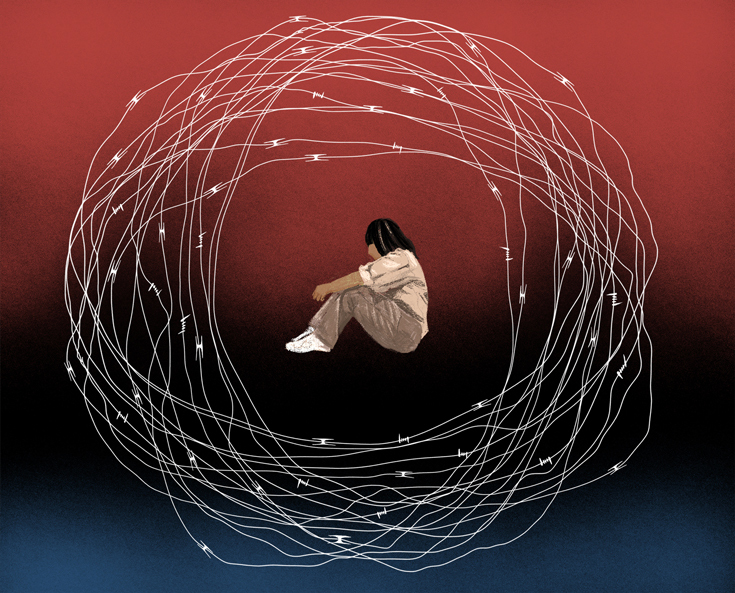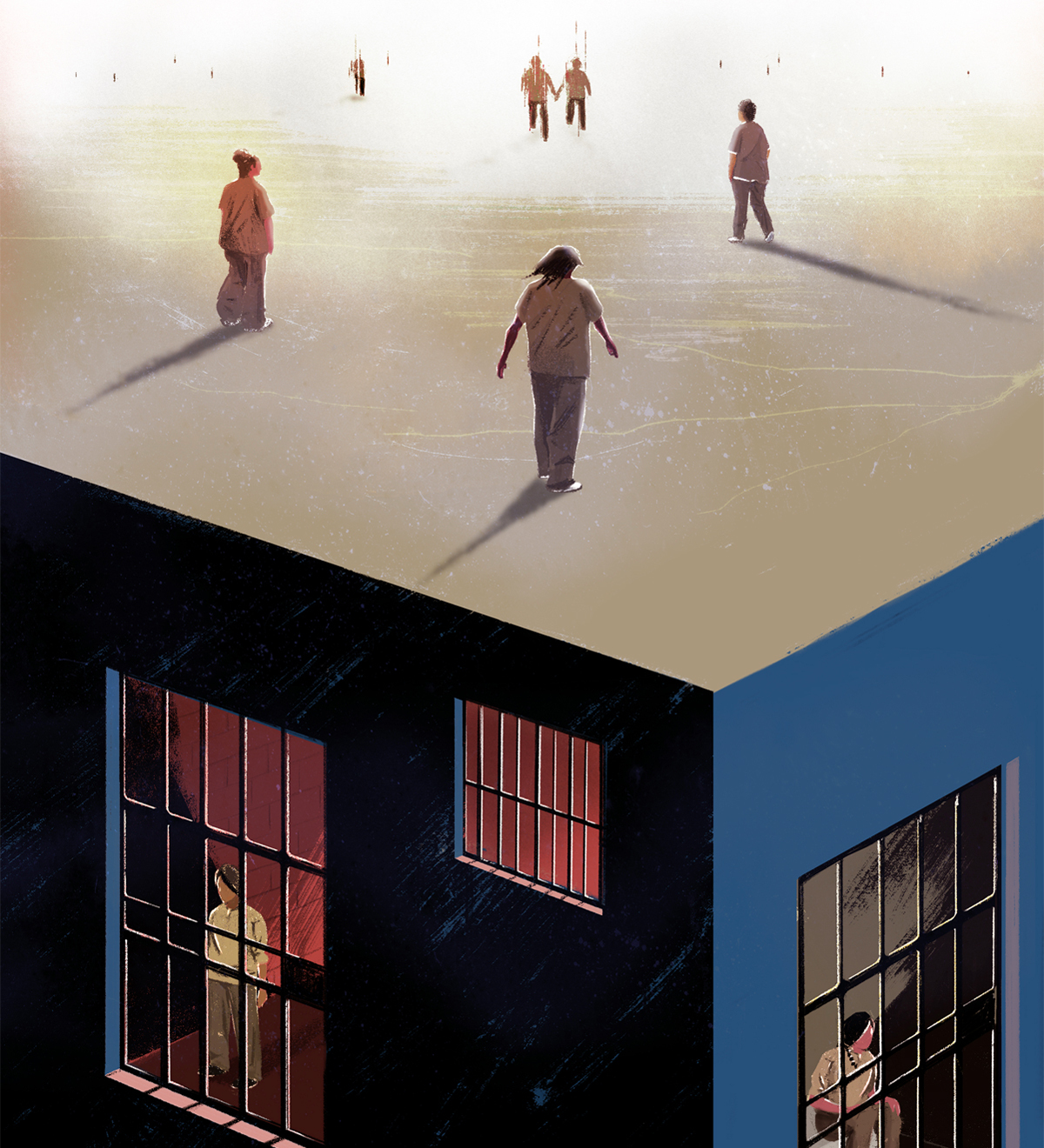At thirty-seven, Treena Smith has been in and out of Nova Scotia’s correctional centres more than fifty times. Her criminal charges have a way of falling into one another: one mistake can trigger a dozen breaches of her probation, dragging Smith back to jail. A reunion with her girlfriend might lead to a party, which could defy no-contact restrictions, break rules against drug and alcohol use, and contravene orders to keep the peace. If the couple gets into a fight, the damage is worse. Each violation also extends Smith’s total probation time, increasing the chances of another slip-up. She doesn’t want to be in prison, but she doesn’t know how to live outside it either. “Prison has become like a safety net,” Smith says over the thrum of voices leaking through the crackly phone line at the Central Nova Scotia Correctional Facility. “What I fear is getting back out into the community. I feel like a failure there. I feel like I don’t really belong anymore.”
Listen to an audio version of this story
For more audio from The Walrus, subscribe to AMI-audio podcasts on iTunes.
Smith is hardly alone. While men still make up the bulk of prisoners, women are Canada’s fastest-growing prison population. Federally, we lock up nearly 40 percent more women than we did a decade ago—a rise that has coincided with cuts to social services nationwide and the overpolicing of racialized communities. Between 2002 and 2012, the number of Indigenous women in federal custody more than doubled. In eastern Canada, Black women and women with disabilities are incarcerated at higher rates than the rest of the population. Most inmates are single mothers. The vast majority have never had steady employment, a bleak reality reflected in the crimes for which they tend to get imprisoned. A quarter of the women in federal custody are there for drug offences, sometimes taking the fall for others. Beyond that, property crimes, such as shoplifting and vandalism, rank as the most common transgressions. Any violence is often in self-defence—against an abusive partner, for example.
Canada spends about
$5 billion
annually to maintain its prisons
In 2016/17, it cost nearly
$84,000/yr
or about
$230/day
to house a woman in a federal prison
Sandra Bucerius heads the University of Alberta Prison Project and is a professor of sociology and criminology at the school. She has interviewed over 600 prisoners in one of the largest qualitative studies on the challenges facing inmates worldwide. Dozens of women have told her that incarceration is better than the alternatives: going hungry, living on the street, being beaten by partners, being unable to afford medication, or facing addiction without access to treatment. But, as Bucerius points out, prisons were never designed to be stand-ins for mental health support, addiction care, employment services, or shelters. Instead, they are structured around ideas of punishment, places where we “lock ’em up”—“them” being Canada’s dangerous and undesirable. Even as notions of reform and healing have muddled their purpose, the ugly truth is that prisons warehouse people we don’t want or don’t know what to do with—people our society has failed to support.
That’s especially true of women prisoners. A 2017 government-led study found that nearly 80 percent of women in federal custody had a mental health disorder, with nearly a third having been diagnosed with ptsd. A full three-quarters struggled with alcohol and substance abuse. Without a robust network of social services outside of prison, the incarceration cycle can be difficult to break. Millions of Canadians report that their mental health needs aren’t fully met, with many saying they can’t afford to change that. Private care for addiction treatment is prohibitively expensive; public wait-lists are long. Prison can begin to feel like the only place where a woman fits in. “I’m alienated out there,” says Smith. “It’s not like you’ve been out of prison for a week and you’re cured and you feel okay being out. It’s a long transition.” To compound it all, women prisoners rarely have stable homes to return to. Or, as Bucerius puts it: “Many prisoners are not going back to houses with picket fences.”
If prisons are what Bucerius calls “a social tragedy,” they’re also an expensive one. In 2016/17, it cost nearly $84,000 a year, or about $230 a day, to house a woman in a federal prison. Overcrowded conditions, as well as the ever-increasing number of people being kept in remand custody—on any given day, 50 percent more incarcerated adults might be awaiting trial or sentencing than those actually in custody—have led those who support prisons to call for their expansion, often under the guise of making them more humane. In 2018, the government estimated that, depending on the type of facility, the price tag for each additional prison bed for women rings in at anywhere between $260,000 and $534,000. Already, Canada spends about $5 billion annually to maintain its prisons. That’s a lot of money for a broken system—one that doesn’t seem to be especially good at deterrence or rehabilitation.
“If we were talking electricity bills,” Ivan Zinger, the federal prison ombudsman, told the Globe and Mail last year, “this would be the equivalent of telling Canadians they are paying the highest hydro rates in the world and getting tons of blackouts.” covid-19 has further pushed the prison plight into the mainstream, exposing just how fast the virus can spread through buildings so overcrowded, unhygienic, and in poor repair. (As of July 1, 360 inmates in federal prisons had contracted covid-19; two had died.) In his reports, Zinger has consistently recommended funnelling more money into the existing, underfunded community programs that can keep former inmates from returning to the system: parole oversight, assistance with accommodation, job searches, and general reintegration into daily life.
It’s a sensible and forward-thinking goal. But many believe it’s no longer enough. For these abolitionists—a movement comprising progressive politicians, criminologists, university professors, community activists, and dozens of human rights organizations—the question isn’t how the prison system can be better, it’s: What if we never sent people to jail at all?
A 2017 government-led study found that nearly
80 percent
of women in federal custody had a mental health disorder
In north america, prisons were first conceived as a kindness. Before the system was created, criminals were banished by Britain and France to penal colonies, or worse, were publicly tortured and executed. In the late 1700s, American Quakers imagined a different system: one in which offenders would instead find penitence through silence, isolation, and religious instruction—hence the term “penitentiary.” Personal reform also played an important part. Prisoners were given a chance to expunge the character deficiencies that had led to their crimes and emerge obedient, newly moral, and essentially transformed. For supporters, penitentiaries were places of salvation and second chances. In June 1835, Canada opened the Kingston Penitentiary, the first large prison in the then burgeoning country. Like its American counterparts, Kingston—which housed mostly men but also women and children—was supposed to change prisoners into perfect citizens through discipline and hard work.
Less than fifteen years later, the strategy unravelled. Whatever good intentions attended their creation, prisons quickly become places to exile Canada’s most unwanted: Black and Indigenous people, independent women and sex workers, the poor, the French. Many prisoners were demonized and, as a result, cruelly treated. The first major investigation into the penitentiary, the Brown Report, was released in 1849 and revealed the corporal punishment of boys and girls, most of them between eleven and fourteen. They were routinely flogged, usually for innocuous infractions, like making faces, winking, and laughing. One eight-year-old boy was beaten forty-seven times in nine months. The Brown Report called their treatment a case of “revolting inhumanity.” Women didn’t fare any better.
According to Ted McCoy’s Hard Time: Reforming the Penitentiary in Nineteenth- Century Canada, most women had been convicted of nonviolent crimes, often theft. Yet the severity of their punishment outweighed their alleged misdeeds. Stuck in a section of the prison so overrun with bugs that their bodies were often blistered with bites, female offenders were physically, emotionally, and sexually abused by guards and inmates alike—in some cases resulting in pregnancy. Many were seen as deserving of the abuse, with one annual report on their treatment dismissing them as “common prostitutes, diseased of body, and debased in mind from a long continuance in a career of crime.” They could not feel shame, the report’s author, a chaplain, insisted, and should not be expected to. This didn’t stop prison officials from demanding intensive labour from female inmates in the name of redemption. In one year, thirty-six women prisoners sewed 6,000 pieces of clothing and darned 10,425 pairs of socks. The Brown Report was a scathing account of penitentiary conditions, but it was met with apathy: the new prison system might not have been working, but what other options were there?

Investigators attempted to answer that question again in the 1930s, amid the Great Depression’s spike in inmate strikes and riots. The Archambault Royal Commission of Inquiry was intended to occasional criminals from becoming habitual offenders and helping nonhabitual offenders become law-abiding, working citizens. Without humane treatment, the commission believed, any punishment was bound to fail. With it, though, prisoners could return to society as better people—an adult version of being grounded. There was only one problem, which the report also acknowledged: nobody had quite yet figured out how to bring that humane treatment about.
One significant thing, however, did change. Under this renewed commitment to prison reform, the Canadian government reaffirmed the need for a separate space for women. (It also resolved to stop imprisoning children in adult facilities.) And yet, while the government appeared to understand the problems with confining women in the same spaces as men, it also decided to model the new women’s prisons primarily after the existing ones for men.
For much of Canada’s history, the Kingston Prison for Women (p4w) was the only federal institution for women in the country. It opened in 1934, directly across from the Kingston Penitentiary, and after enduring countless controversies over extreme prisoner maltreatment, it finally shuttered in 2000. In that time, eight government task forces and commissions recommended its closure, including one four years after it opened and another in 1977 that famously declared the prison “unfit for bears, much less women.”
Plans were already underway for p4w’s closure when things went very wrong in late April 1994. It started with a brief but violent confrontation between six women and correctional staff. The women were placed in segregation, also known as solitary confinement, which only escalated tensions in the rest of the prison. An inmate took a hostage, another attempted suicide. As the situation worsened, the prison’s warden called in an all-male response team from the nearby Kingston Penitentiary to stripsearch the segregated women. Afterward, the men, nicknamed the “goon squad” by prisoners, left the women in paper gowns, restraints, and leg irons. The humiliating incident was filmed and later leaked to the cbc’s The Fifth Estate. Outrage followed. Soon afterward, the federal government appointed Justice Louise Arbour to investigate the incident and the reaction of Correctional Service Canada (csc).
In her report, Arbour noted the timing of the p4w incident. In 1990, the government- appointed Task Force of Federally Sentenced Women had debuted a new vision for women’s prisons called Creating Choices. Emphasizing empowerment, the fundamental guarantee of respect and dignity, and the recognition that societal barriers played a major role in women’s paths to prison, the task force recommended the closure of p4w and the creation of four separate regional facilities and a healing lodge. These new prisons were to include housing complexes that resembled cottages, ample time for women to spend outdoors, vocational training that also included vacation time, support for mothers, mental health and addiction treatment, and access to all levels of education, health care, and trauma counselling.
At the healing lodge, no weapons were used and the word “guard” was replaced with a Cree word meaning “aunty” or “older sister.” (Elders at the facility were mostly women.) There were no fences: boundaries were instead marked by coloured cloths tied to trees. Under the Creating Choices philosophy, these facilities would focus less on punishment and more on recovery—a formula that would supposedly return, happier, healthier women to society.
Unsurprisingly, many prison-reform advocates praised Creating Choices. But it was The Fifth Estate’s footage of the strip search that helped change the larger public’s opinion toward prisons. By the time p4w closed, the groundwork for Creating Choices was being laid. Federal officers put the last p4w prisoner, fifty-year-old Theresa Ann Glaremin, into a car on the morning of May 8, 2000. Several years beforehand, Glaremin, an Indigenous woman convicted of murder, described her prison experience in a poem for Tightwire, a journal created by p4w inmates. “Darkness never comes in prison,” she wrote, “until they cut us down and carefully lay us in a body bag.”
The new system was meant to prevent such experiences, but many prisoners, who had been given scant information on how the new facilities would work, felt apprehensive about leaving p4w. It was what they knew; some called it home. Glaremin told media, “I look at it this way: it’s not a step backward, it’s a step forward. And that’s how I have to look at it in order to get through it because I don’t want to leave.” Meanwhile, Canadian politicians congratulated themselves on leading the world in gender-sensitive correctional reform. The celebration, however, was short-lived.
Once creating choices was accepted as the new guiding philosophy for women’s prisons, its implementation fell entirely to csc. And, though csc appeared to embrace the idea of “healing,” it did little to make that possible beyond building new facilities—facilities which immediately started to look less and less like the original vision for Creating Choices. As Arbour presciently noted in her report: “Despite its recent initiative [on reform], the Correctional Service resorts invariably to the view that women’s prisons are, or should be, just like any other prison.”
The first evidence of this emerged shortly after the opening of the Edmonton Institution for Women, in November 1995. Not only did Edmonton open before construction was complete, with few programs in place, but csc transferred a disproportionate number of maximum-security women there—many more than it was equipped to safely handle. Combined with the abrupt shift to the new approach, the move created a pressure cooker of untrained staff, scant security, and women with complex needs.
Within five months, there were escapes, more than a dozen incidents of self-harm, two suicide attempts, and one murder. Staff training and management practices hadn’t changed to meet the new ideals, and the deteriorating situation in the prison hastened a return to dehumanizing methods of control. Many of the women there had also not been properly prepared to embrace the Creating Choices mandate—after years of trauma and incarceration, they were suddenly expected to resolve disputes communally.
The fault for all this did not lay entirely with the csc. Creating Choices had been reluctant to label women as violent or otherwise “difficult to manage” and thus did not plan for them, expecting a changed environment to be enough. When it wasn’t, csc resorted to old tactics—segregation, maximum security, punishment—rather than working harder to ease the transition.
The mistake in Edmonton reverberated through the other new prisons. Openings were delayed in Kitchener and Joliette, Quebec, as csc scrambled to increase security at the new facilities. Twenty five percent of total bed space in the other prisons was made more secure. Daycares and gymnasiums were eliminated. Eight-foot-high fences were erected. More cameras were installed. Segregation was reinstated; some women were, once again, temporarily confined in men’s prisons. Under these impossible conditions, the responsibility for healing and reform was then placed on women themselves. Programming shifted away from individualized needs and toward parole-board requirements. Acknowledgement and analysis of systemic problems were abandoned in favour of fixing bad behaviour. To top it off, the government never funded the community services essential to Creating Choices.
Each error was like removing a block from a wobbly Jenga tower. Today, all evidence of the report’s good intentions is gone, says Kelly Hannah-Moffat, a professor of criminology and sociolegal studies at the University of Toronto and the former director of the Centre for Criminology and Sociolegal Studies. Hannah-Moffat also acted as a policy adviser to Arbour during her investigation. It wasn’t very long after p4w closed, she says, that csc reframed the operational outcomes in Creating Choices as “ideals.” Soon after that, even those ideals were discarded.
It’s tempting to call this a failure of women’s-prison reform, but Canada hasn’t had much success reforming men’s prisons either. Too often, reform fails because of contradictory objectives: preserving ideals of punishment and confinement while also offering healing and redemption. “They were attempting to change the way prison works,” says Hannah-Moffat, referring to Creating Choices. “But prison is a fundamentally disempowering situation.”
One of the saddest examples of this is Ashley Smith. In October 2007, less than a decade after p4w closed, the nineteen-year-old was found unconscious at Kitchener’s Grand Valley Institution for Women, a Creating Choices facility. She later died from what was at first ruled “self-initiated asphyxiation.” Guards had watched her tie a ligature around her neck, but after intervening in dozens of similar incidents in the past, they had been ordered not to enter her cell so long as she was breathing. Smith had been in a youth facility since 2003, then segregated for the entire eleven and a half months she’d been behind bars, which included seventeen transfers between nine facilities. Contrary to Creating Choices values, Smith never received a psychological assessment and had scant access to mental health services despite multiple instances of self-harm. A 2013 inquiry ruled her death a homicide. Why was Smith first sent to jail? For breaching probation by throwing crab apples at a postal worker.
The history of prisons, and of prison reform, shows that neither approach has worked. People do not tend to find compassion in cages. Nor are they rehabilitated. Prisons exist,
as one article puts it, “because we do not know what else to do.” That failure of imagination is why Justin Piché has called prisons “impervious to reform.” A professor of criminology at the University of Ottawa, Piché is also a founding member of the Criminalization and Punishment Education Project, one of several groups in Canada largely responsible for the renewed push to abandon prison reform altogether in favour of something more radical: abolition. Abolition argues for freedom—freedom for all genders and, usually, for all crimes. It argues that incarceration makes nobody better. In fact, it argues, prisons make people worse.
Recidivism rates—by which many people measure the success or failure of rehabilitation—are notoriously difficult to come by in Canada. The most recent federal numbers, released last year, look at the five-year period between 2007 and 2012. They reveal that, within two years of their release, 24 percent of men and 12 percent of women reoffend. Other studies have found much higher recidivism rates when provincial sentencing is included, bringing the national number to over 40 percent. Individual provincial rates can be even higher—since 2001, for example, Ontario’s recidivism rates have fluctuated between nearly 35 and 55 percent. “The paradoxical success of the prison (as a means of punishing the deviant) is dependent on its continuing failure as a place of rehabilitation,” wrote University of Alberta sociologist Stephanie Hayman. “The prison cannot afford to succeed, because success would limit its power.”
It doesn’t have to be this way. Elsewhere in the world, reform has been more successful, largely because it hasn’t been half-hearted, quickly discarded, or both. Norway’s Halden Prison is held up as an example of true reform—one, incidentally, that has embraced many of the principles Canada failed to implement with Creating Choices. It has no bars on its windows, each inmate has their own cell, staff participate in activities alongside prisoners, and a wide array of vocational training is available, including a recording studio. The safety net upon release is wide: former prisoners are offered housing support, social assistance, and disability insurance. As a result of Norway’s reformed prison system, recidivism rates are extremely low. In the Netherlands, a similar approach has created abolition-like conditions. As crime rates dropped, helped along by a pattern of shorter and alternative sentencing as well as increased social supports, the country began to shutter its emptying prisons. By 2019, reported the Independent, it had closed more than half, and another four closures were scheduled.
The first step for abolition is a moratorium on building new prisons. Abolitionists argue the money is better spent on housing, health, and community programs, including models of restorative justice, which aims to heal the harm caused by crime, not punish those who cause it. After a moratorium comes something trickier: decarceration, or finding ways to get people out of prison. In the wake of covid-19, abolitionists, as well as prisoners and health experts, have pushed to release as many prisoners as possible to stem the pandemic, which could be disastrous in packed prisons, where physical distancing is impossible and health is already poor. In one Laval federal prison, 162 cases and one death were confirmed by the end of June. By July, more than fifty inmates at Quebec’s Joliette Institution for Women had contracted the virus. One Ontario jail temporarily shut down in mid-April after sixty inmates and eight guards tested positive. Instead of releasing inmates, the prison simply transferred them. “If they continue to batten down the hatches and wait for the storm to pass,” said Piché in April, referring to Prime Minister Justin Trudeau and Minister of Public Safety Bill Blair, “the only depopulation of penitentiaries will be through hospitalizations and deaths in custody.”
With the help of lawyers, abolitionists have had success securing release for prisoners convicted of nonviolent crimes, those near the end of their sentences, and those in remand custody. Since the outbreak, Nunavut has released more than twenty prisoners from an inmate population of 144, prompting the ceo of the Legal Services Board of Nunavut to ask: “If it was safe to release these people, why were they ever detained in the first place?”
Questions like these have introduced the last step of abolition—excarceration—into the conversation. Excarceration involves putting in place the necessary social supports to ensure that people who have been incarcerated never return and those who haven’t been never are. In short, it means nobody would ever go to jail or prison again. Such a move would profoundly change the way we view crime, accountability, rehabilitation—and even redemption. For all these reasons, it’s often the hardest step for people to support. People who may agree that prisons are bad places often want a way to lock up Canada’s most notorious: Paul Bernardo, Karla Homolka, Robert Pickton, or Luka Magnotta. Even among abolitionists, this is where things get sticky, with some believing in absolute abolition and others, like researcher Sandra Bucerius, believing some individuals can’t integrate back into society.
Canadian senator Kim Pate understands many people’s knee-jerk “do the crime, do the time” reaction. If not for jails, what would we do with our murderers and rapists? As a law school graduate, she once felt that way herself. But, after witnessing the fallout of a failed system, she began advocating against the idea of incarceration as a one-size-fits-all answer to crime—particularly for women, who are more likely to be survivors of violence rather than its perpetrators.
For Pate and other abolitionists, the real question comes back to: What could we do with all the money spent on imprisoning people if we thought creatively? If we weren’t basing an entire system on the few truly evil crimes? Though the dream of Creating Choices ultimately failed, Pate believes it got one thing right: women need a solution as unique as their challenges. “I don’t believe sitting here biding our time is helping anybody,” says Treena Smith. “I believe in rehabilitation and in helping people find some peace within themselves again.”
In 2018, Pate met with Smith and several other women in the Central Nova Scotia Correctional Facility. Over several days, the senator dared them to think outside the prison box, past traditional ideas of reform and failed solutions like Creating Choices. In response, the women imagined something called From the Ground Up. With markers and Bristol boards, they sketched out the vision of a community that would exist
on a wide plot of tree-studded land. It would have no fences, no guards. It would be rich in mental health and addiction programs. Staff would include women who had been inmates as well as people with experiences similar to those of the women they were helping. It would create jobs for women who’d been through its programming, sending them to school. Most importantly, it would be a place women could go instead of prison, maybe even before they ever committed a crime.
Eventually, the women began to wonder why From the Ground Up couldn’t happen. Soon, they were sharing their plans with legislators, architects, urban planners, even prison staff. Their momentum is captured in the documentary Conviction. Released last year, the film features the experiences of Smith and several other women inside the penal system, as well as their fight to make From the Ground Up a reality. Not only did directors—Ariella Pahlke, Teresa MacInnes, and Nance Ackerman—spend three months following the women’s lives inside the Central Nova Scotia Correctional Facility and Nova Scotia Institution for Women but they gave camcorders to prisoners so that they could film their lives on the outside. The women featured in the doc also had control over what footage could be used in the final cut. Such trust, collaboration, and access was so unprecedented that guards and prisoners alike found the experience life-changing.
Shortly after the film wrapped, Tanya Bignell stopped working at her correctional facility. Part of why she left, she says, was to dedicate more time to From the Ground Up. While Bignell may seem like an unlikely ally, she was always “on the fence with the way things are run.” After a decade as a correctional officer, she herself began to feel institutionalized, living a split reality inside and outside the prison—except, she realized, unlike her charges, she could go home at the end of the day. She’s been diagnosed with ptsd, a condition linked with her other reason for quitting: the job compounded her trauma. She remembers strip-searching a woman who had been assaulted. It was the woman’s first time in jail and, at news of the search, she broke down. Bignell assured her that she wouldn’t touch her but knew the search was going to happen whether or not she was the one to do it. It was yet another example of how, as Hayman wrote, “the prison always triumphs.”
So Bignell teamed up with former prisoners to find a better way. One of her most ardent colleagues was Bianca Mercer, an inmate with a history of trauma and drug abuse. In 2016 and 2017, Mercer was incarcerated while pregnant. At six months, after weeks of solitary confinement, she was transferred from the jail where Bignell worked into a housing program. There, in mid-May, she gave birth to a stillborn child. She vowed never to go back to jail. And she hasn’t. I spoke with Mercer last January, just short weeks after the healthy birth of her daughter. Mercer was enrolled in college and leading the charge to get From the Ground Up built. Her vision emphasized individualized programming and extended support while women transition into their own homes. Women could stay in the program for as long as they needed to. They would never send someone away with little more than a bus ticket and a “good luck” wish. “Jail doesn’t work because it’s based on punishment,” she says. “They say there’s rehabilitation involved, but I never had any help.”
From the Ground Up Women’s Wellness Society was incorporated on February 6. Of course, it’s still just a concept, and even if the community is eventually built, it’s only one alternative in a country full of prisons. Mercer, Bignell, Smith, and others all know From the Ground Up has a long way to go before it replaces incarceration. And, for now, covid-19 has put their plans on pause. But that first step remains extraordinary, a rare case of the prison system actually doing what its founders envisioned centuries ago: it made something better.




